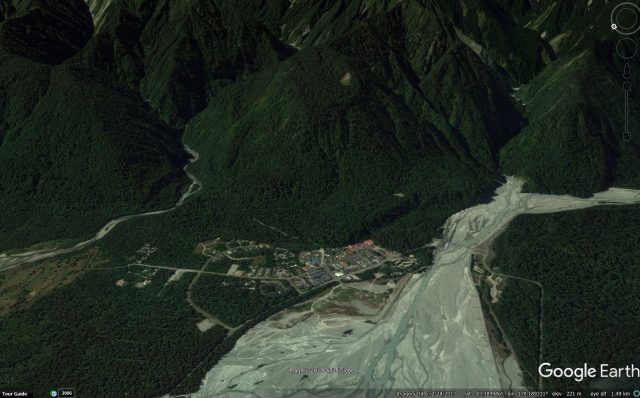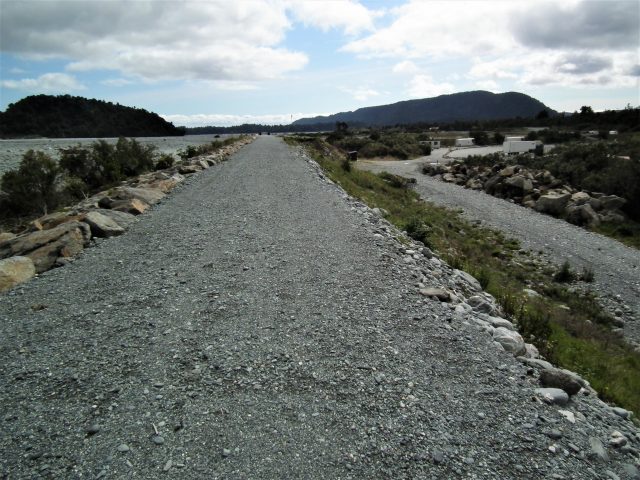3 November 2017
Managing the hazards in Franz Josef, New Zealand
Posted by Dave Petley
Managing the hazards in Franz Josef, New Zealand
Franz Josef is a small town on the west side of South Island in New Zealand. Whilst its permanent population is small (510 people), it hosts about 700,000 visitors per year, many of whom visit the Franz Josef Glacier. Unfortunately, Franz Josef is also one of the most hazard-prone communities in New Zealand. Located right on the range front, Franz Josef is built upon the Alpine Fault, which typically ruptures about every 300 years (last event 1717); it is next to the Waiho River, which has an increasing level of flood risk due to aggredation of the river bed; and it is below a slope that is potentially unstable in a large earthquake (and which I described previously). These hazards can be seen in this Google Earth image of the town and surrounding landscape:-

Google Earth image showing the landscape around the town of Franz Josef in New Zealand
.
To consider the pros and cons of the various options, the local authority (West Coast Regional Council) have commissioned a study by Tonkin and Tayor, which is now available online as a PDF. This study has examined a range of options for the town, including complete relocation and a minimal intervention approach. The conclusions are clear:
Do nothing is not an option
There is significant flood hazard at present, and due to ongoing bed aggradation that flood risk (and the cost of mitigating it) increases with time. There is already flood risk to assets below the river bed. If left unmanaged, it is likely to be less than 30 years before the Waiho River is above the level of the township. This places a level of urgency on a decision to manage the risk from this hazard.
Additionally, an Alpine Fault rupture event would cause significant disruption to Franz Josef township, including impacts caused by shaking across the wider Franz Josef area and uplift and / or lateral spread along the active fault line(s). It is also possible (if not probable) that an Alpine Fault rupture could trigger a large landslide, which would have catastrophic consequences in terms of loss of life, building stock and tourist revenue.

A stopbank on the Waiho River in New Zealand, protecting the town of Franz Josef. Note the height of the river bed on the left side, and the elevation of the buildings on the right.
.
The report proposes three options in terms of interventions:-
Avoid nature’s most significant challenges: This package seeks to physically avoid the natural hazard challenges in Franz Josef by moving the township to Lake Mapourika, out of the area subject to flooding from the Waiho River and away from the Alpine Fault and the range-front landslide risk. This package may create new investment opportunities, in addition to protecting the tourism value currently generated by the township.
Live with nature’s challenges: This package involves generally decreasing stopbank management and allowing the river to fan out in its natural pattern, which will reduce flooding risk and flood management costs. It also allows for relocating township assets off the active known fault line in the short- to medium-term; however, over time the value of the land to the south of the Waiho River will be eroded due to increased flooding risk.
Defend against nature’s challenges: This package involves continuing to build stopbanks and implementing a gravel extraction programme to allow the township, and the businesses and residents in the wider Franz Josef area, to remain in their current locations with lower flooding risk. It also allows for relocating township assets off the active known fault line in the short to medium-term to reduce earthquake-related risk. The costs of gravel management will occur in perpetuity and the town will remain exposed to residual flooding risk from stopbank failure or overtopping.
Unfortunately none of the options is compelling relative to the others, and all have pros and cons. For example, the cost of relocating the town to Lake Mapourika is estimated to be about NZ$300 million with an anticipated benefit of just NZ$120 million.
The report makes kit clear that the magnitude of the problem is so large that this is a national level problem, rather than one that can be managed regionally. But the solution is far from clear for a country already dealing with the effects of recent large earthquakes.


 Dave Petley is the Vice-Chancellor of the University of Hull in the United Kingdom. His blog provides commentary and analysis of landslide events occurring worldwide, including the landslides themselves, latest research, and conferences and meetings.
Dave Petley is the Vice-Chancellor of the University of Hull in the United Kingdom. His blog provides commentary and analysis of landslide events occurring worldwide, including the landslides themselves, latest research, and conferences and meetings.
I have recently returned to the UK after visiting NZ.
My wife and i also visited the Franz Josef glacier using the well managed footpath to the glacier site.
I also visited the same glacier and fox in 1984 whilst working in NZ as an agricultural exchange student. I have memeries of walking up the riverbed then to acess the glacier. Also have pictures from 84 without showing a footpath. Please could you tell me when the footpath was built.
Mamy thanks. Keith